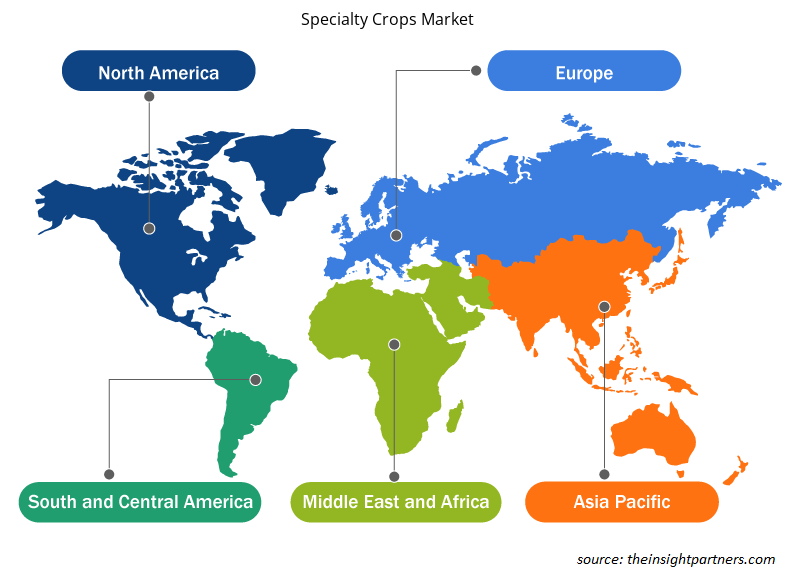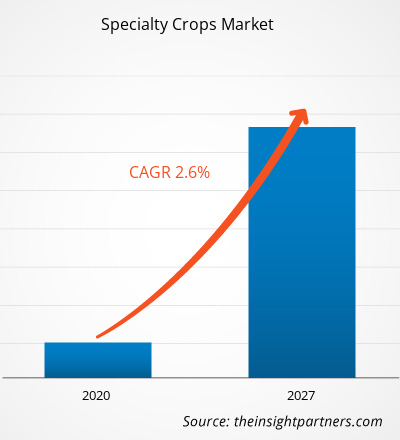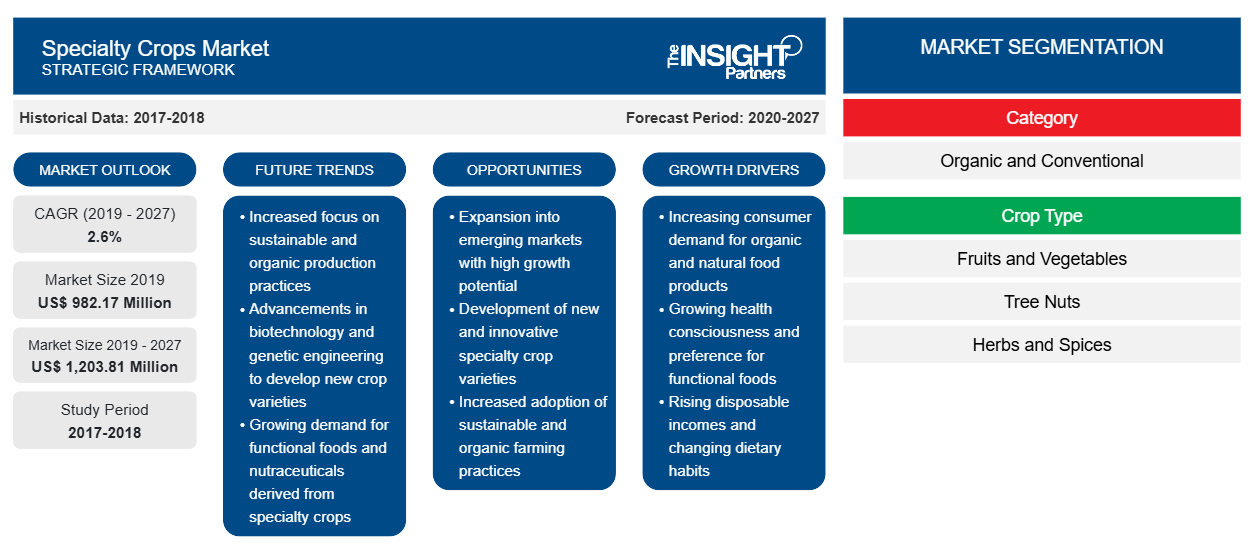特殊作物市場は2019年に9億8,217万米ドルと評価され、2027年までに12億381万米ドルに達すると予測されており、2020年から2027年にかけて2.6%のCAGRで成長すると予想されています。
特産作物とは、果物や野菜、木の実、ドライフルーツ、園芸、苗木(花卉栽培を含む)を指します。また、気候や地形上の特徴により、地域全体で特別に栽培される外来作物も含まれます。人口の増加と一人当たり可処分所得の増加により、消費者の食習慣にパラダイムシフトが見られ、健康的でおいしい食品の需要に直接影響を与えています。さらに、急速な都市化、民族構成、健康への懸念、人口動態の変化も、特産作物の需要を促進する要因です。特産作物の適用範囲の拡大、政府の支援策、自由貿易政策は、特産作物市場を牽引する主な要因です。しかし、環境や貿易の障壁が特産作物市場の成長を制限しています。
2019年、アジア太平洋地域は世界の特産作物市場で最大のシェアを占めました。この地域はいくつかの新興国で構成されており、国民の可処分所得の増加により、消費者のライフスタイルは急速に変化しています。さらに、西洋のライフスタイルと急速な都市化の影響により、この地域ではインスタント食品の成長が促進されています。この地域の顧客は植物ベースの食品に非常に惹かれており、それがさらに特産作物市場の成長につながっています。最適な市場シェアを獲得するために、この地域の企業はさまざまな技術を導入しています。たとえば、中国の企業は市場の需要を満たすために加速熟成貯蔵を使用しています。加速熟成により、自然に熟した果物と同様の色、香り、味が保証されます。多くのプレーヤーが加速熟成の必要性と重要性を認識し始めており、加速熟成倉庫を設立しています。
COVID-19は2019年12月に中国の武漢で始まり、それ以来世界中に広がっています。2021年2月現在、米国、インド、ブラジル、ロシア、英国、フランス、スペイン、イタリア、トルコ、ドイツ、コロンビア、アルゼンチンは、確認された症例と報告された死亡者数で最も影響を受けている国の一部です。最新のWHOの数字によると、世界で確認された症例は約102,584,351件、死亡者数は合計で約2,222,647人です。コロナウイルスの発生は、ロックダウン、渡航禁止、事業閉鎖により、さまざまな国の経済や産業に影響を及ぼしています。農業業界は、この発生の結果、サプライチェーンの中断、技術イベントのキャンセル、オフィスの閉鎖など、深刻な混乱に見舞われている主要産業の1つです。北米、ヨーロッパ、アジア太平洋、南米、中東およびアフリカのさまざまな工場の閉鎖は、世界のサプライチェーンに影響を及ぼし、さまざまな商品の製造、配送スケジュール、販売に悪影響を及ぼしています。
特殊作物市場は過去10年間、一貫して成長してきました。しかし、COVID-19パンデミックの発生により、業界は独自の課題に直面し、継続的な成長が脅かされました。そのため、さまざまな政府が、特殊作物農家が市場の勢いを取り戻すための支援を提供しています。たとえば、米国農務省(USDA)は、コロナウイルス農業支援プログラムの一環として、5%以上の価格下落に見舞われた農産物の生産者や、COVID-19による市場サプライチェーンの混乱により損失を被った農産物の生産者に重要な財政支援を提供しています。したがって、政府によるこのような有利な取り組みは、特殊作物市場のプレーヤーを助けると見込まれています。
要件に合わせてレポートをカスタマイズする
このレポートの一部、国レベルの分析、Excelデータパックなど、あらゆるレポートを無料でカスタマイズできます。また、スタートアップや大学向けのお得なオファーや割引もご利用いただけます。
- このレポートの主要な市場動向を入手してください。この無料サンプルには、市場動向から見積もりや予測に至るまでのデータ分析が含まれます。
市場分析
政府の支援策と自由貿易政策
特産作物の成長は、販売およびマーケティング活動、植物の害虫および病気の予防、研究開発など、政府の積極的な取り組みによって強力にサポートされています。たとえば、2018年に可決された農業法案(2018年農業改良法)は、果物や野菜、木の実、苗木などのいくつかの特産作物の成長を促進するために現在のプログラムを再認可および拡張することを目的としていました。農業法案は、特産作物ブロック助成金プログラムと特産作物市場ニュースを通じて特産作物生産者に支援を提供するために実施されました。これらのプログラムを通じて、USDAは競争力の向上と、マーケティング、害虫管理、研究、食品安全の支援に重点を置いています。この法案はまた、特産作物を取り巻くいくつかの貿易問題を認識しており、技術支援と輸出支援を提供しています。これとは別に、研究機関である特産作物研究イニシアチブ(SCRI)が、コラボレーション、オープンなコミュニケーション、情報交換を促進する目的で設立されました。さらに、政府はCOVID-19パンデミックの影響を受けた特産作物生産者を支援するために食糧支援プログラムを提供しました。この支援は、園芸、木の実、果物、野菜、藍など、特産作物の栽培を促進するために提供されました。USDAは、市場の混乱と価格変動に苦しむ生産者のために、コロナウイルス食糧支援プログラム2を強化しています。さらに、インドでは、政府は苗木作物の栽培を促進するためにポリまたは温室に50%の補助金を提供することを決定しました。政府のプログラムとは別に、自由貿易政策も実施されており、サプライチェーンプロセスが大幅に統合され、貿易量が増加し、より高品質で低価格の商品にアクセスできるようになるなど、効果的な貿易活動につながっています。
カテゴリーインサイト
カテゴリーに基づいて、世界の特産作物市場は、有機栽培と従来栽培に分けられています。 2019年、従来栽培セグメントが世界の特産作物市場をリードしました。 従来栽培は、合成肥料、農薬、その他の化学物質を使用する最も実践されている農法の1つです。 従来栽培技術は、より低い生産コストでより高い収量を得るために、小規模農家や限界農家の間で広く採用されています。 この技術は、コストに比べて収量が高いため、生産者や栽培者に有利です。 さらに、有機栽培に伴う健康と環境へのメリットに関する農家の知識不足が、このセグメントの成長を促進しています。 ただし、この方法に関連する欠点がいくつかあります。 従来の方法で栽培された作物には、合成農薬の使用により化学残留物が含まれており、動物や人間にとって危険な場合があります。
作物の種類に関する洞察
作物の種類別に見ると、世界の特産作物市場は、果物と野菜、木の実、ハーブとスパイス、その他に分類されます。果物と野菜のセグメントは、2019年に世界の特産作物市場を支配しました。果物と野菜は農業生産の重要な部分を占めており、商業目的と家庭用の両方で年間を通じて広く栽培されています。果物と野菜の世界的な需要は、その高い栄養プロファイルのために高くなっています。直接の国内消費とは別に、これらの作物は多様な最終用途産業で使用されています。USDAは、リンゴ、アボカド、バナナ、ブラックベリー、ブルーベリー、パンノキ、カカオ、チェリモヤ、チェリー、チョークベリー、柑橘類、ココナッツ、コーヒー、クランベリー、カラント、ナツメヤシ、フェイジョアフルーツ、イチジク、グーズベリー、ブドウ(レーズンを含む)、グアバ、キウイ、ライチ、マカダミア、マンゴー、ネクタリン、オリーブなど、さまざまな果物を特産作物として定義および分類しています。また、アーティチョーク、アスパラガス、ビート、ブロッコリー、ニンジン、カリフラワー、セロリ、セロリ、ひよこ豆、チャイブ、コラード、キュウリ、枝豆、ナス、エンダイブ、エンドウ豆(庭、乾燥、食用)、ニンニク、ホースラディッシュ、コールラビ、ネギ、レンズ豆、レタスなど、さまざまな野菜を特産作物として分類しています。オーガニック農産物に関連する健康上の利点に関する消費者の意識の高まりにより、オーガニックで栽培された特産の果物や野菜の需要も増加しています。さらに、急速な都市化と健康的なライフスタイルへの消費者の好みの変化により、果物や野菜を食生活に取り入れることが奨励され、それによってこのセグメントの成長が促進されています。
合併や買収、研究開発は、企業が世界規模で事業を拡大するために一般的に採用されている戦略であり、市場規模にさらなる影響を与えています。特殊作物市場のプレーヤーは、顧客基盤を拡大し、世界中で大きな市場シェアを獲得するために、合併や買収、研究開発戦略を実施しており、これによりプレーヤーは世界的にブランド名を維持することもできます。
特産作物市場の地域別洞察
予測期間を通じて特殊作物市場に影響を与える地域的な傾向と要因は、Insight Partners のアナリストによって徹底的に説明されています。このセクションでは、北米、ヨーロッパ、アジア太平洋、中東、アフリカ、南米、中米にわたる特殊作物市場のセグメントと地理についても説明します。

- 特産作物市場の地域別データを入手
特殊作物市場レポートの範囲
| レポート属性 | 詳細 |
|---|---|
| 2019年の市場規模 | 9億8,217万米ドル |
| 2027年までの市場規模 | 12億381万米ドル |
| 世界のCAGR(2019年 - 2027年) | 2.6% |
| 履歴データ | 2017-2018 |
| 予測期間 | 2020-2027 |
| 対象セグメント | カテゴリー別
|
| 対象地域と国 | 北米
|
| 市場リーダーと主要企業プロフィール |
|
特殊作物市場のプレーヤー密度:ビジネスダイナミクスへの影響を理解する
特殊作物市場は、消費者の嗜好の変化、技術の進歩、製品の利点に対する認識の高まりなどの要因により、エンドユーザーの需要が高まり、急速に成長しています。需要が高まるにつれて、企業は提供品を拡大し、消費者のニーズを満たすために革新し、新たなトレンドを活用し、市場の成長をさらに促進しています。
市場プレーヤー密度とは、特定の市場または業界内で活動している企業または会社の分布を指します。これは、特定の市場スペースに、その規模または総市場価値と比較して、どれだけの競合相手 (市場プレーヤー) が存在するかを示します。
特殊作物市場で事業を展開している主要企業は次のとおりです。
- ダイヤモンドフルーツ株式会社
- ハーバースパイス株式会社
- オラムインターナショナル
- オレゴンスパイスカンパニー
- スペシャルティクロップカンパニー。
免責事項:上記の企業は、特定の順序でランク付けされていません。

- 特殊作物市場のトップキープレーヤーの概要を入手
レポートの注目点
- 世界の特殊作物市場における進歩的な業界動向は、プレーヤーが効果的な長期戦略を策定するのに役立ちます。
- 先進国市場と発展途上国市場で採用されているビジネス成長戦略
- 2017年から2027年までの世界の特産作物市場の定量分析
- さまざまな業界における世界の特産作物の需要の推定
- 市場の成長を予測するために業界で活動しているバイヤーとサプライヤーの有効性を示すPEST分析
- 競争的な市場シナリオと世界的特産作物の需要を理解するための最近の動向
- 世界の特殊作物市場の成長を牽引・抑制する要因と相まって、市場の動向と見通しが明らかになった。
- 世界の特産作物市場の成長に関する商業的利益を支える戦略を理解することによる意思決定プロセス
- 世界の特産作物市場規模(市場のさまざまなノード)
- 世界の特殊作物市場の詳細な概要とセグメンテーション、および業界におけるその動向
- 有望な成長機会があるさまざまな地域における世界の特産作物の市場規模
世界の特殊作物市場 – カテゴリー別
- オーガニック
- 従来の
世界の特殊作物市場 – 作物タイプ別
- 果物と野菜
- 木の実
- ハーブとスパイス
- その他
企業プロフィール
- ダイヤモンドフルーツ株式会社
- ハーバースパイス株式会社
- オラムインターナショナル
- オレゴンスパイスカンパニー
- スペシャルティクロップカンパニー
- バナベイリミテッド
- ライスフルーツカンパニー
- フィッシャーナットカンパニー
- シンプドフーズ株式会社
- SVZ 産業用果物・野菜原料
- 過去2年間の分析、基準年、CAGRによる予測(7年間)
- PEST分析とSWOT分析
- 市場規模価値/数量 - 世界、地域、国
- 業界と競争環境
- Excel データセット
最新レポート
お客様の声
購入理由
- 情報に基づいた意思決定
- 市場動向の理解
- 競合分析
- 顧客インサイト
- 市場予測
- リスク軽減
- 戦略計画
- 投資の正当性
- 新興市場の特定
- マーケティング戦略の強化
- 業務効率の向上
- 規制動向への対応





















 無料サンプルを入手 - 特産作物市場
無料サンプルを入手 - 特産作物市場